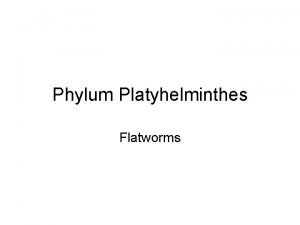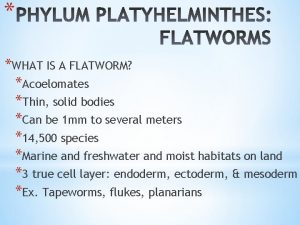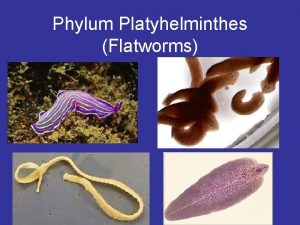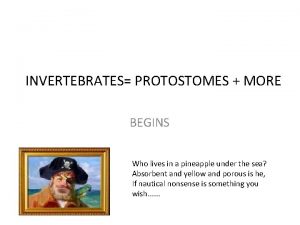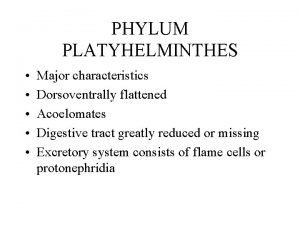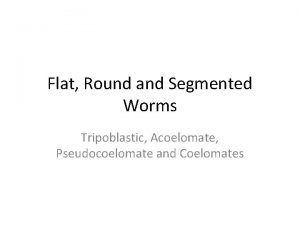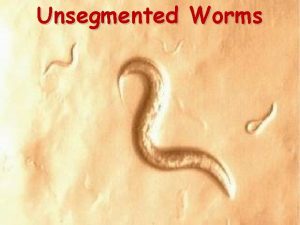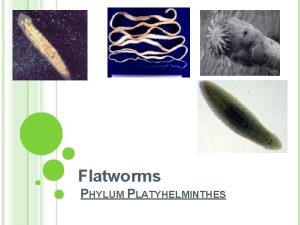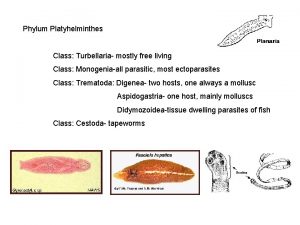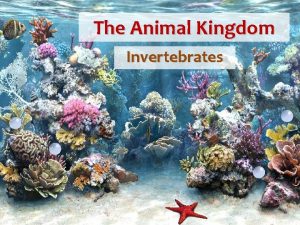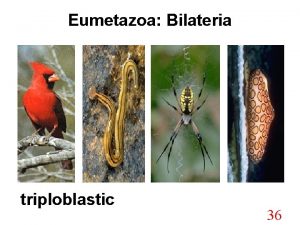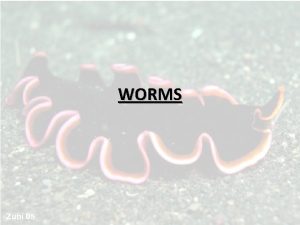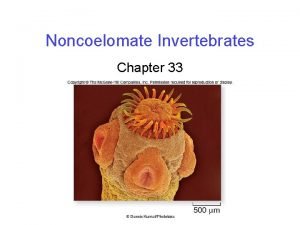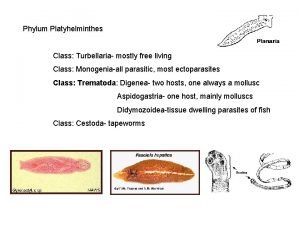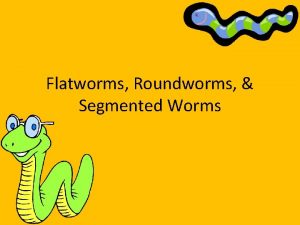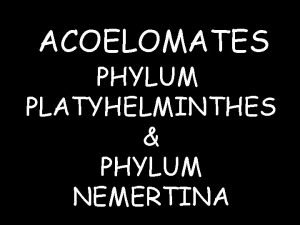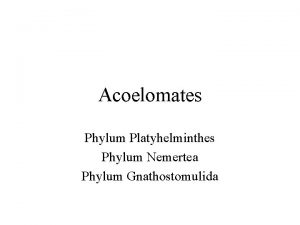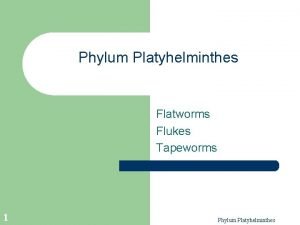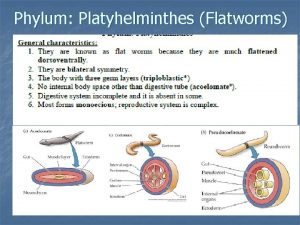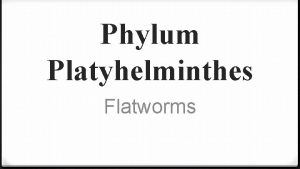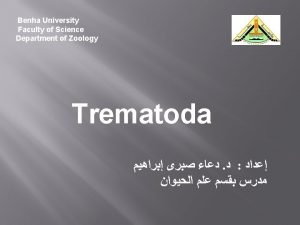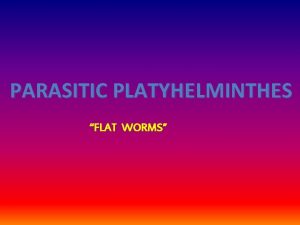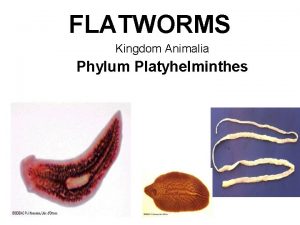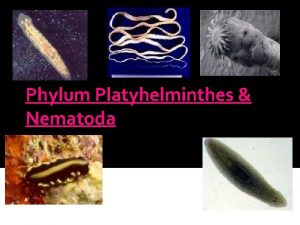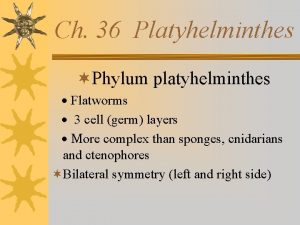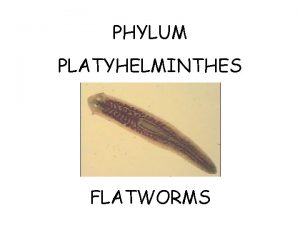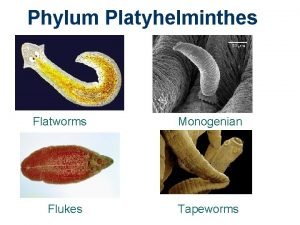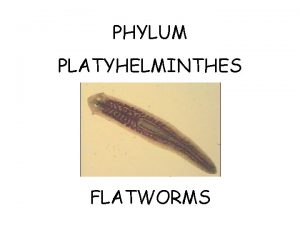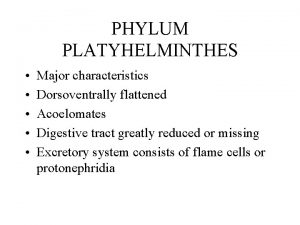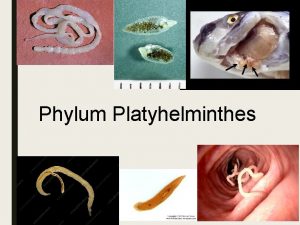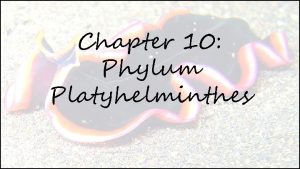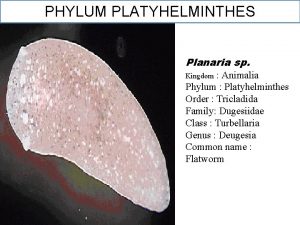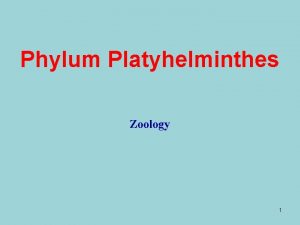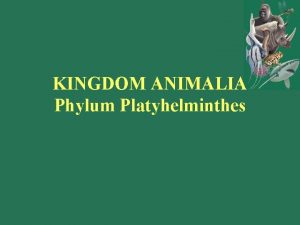Phylum Platyhelminthes Flatworms Flatworms The Platyhelminthes Acoelomates no

























- Slides: 25

Phylum Platyhelminthes Flatworms

Flatworms: The Platyhelminthes Acoelomates: no coelom Bilateral symmetry Cephalization: with simple nervous system in the form of ganglia knotted at head and extending the body as a nerve cord.

Eye spots, ocelli, at anterior part of the body called the head. Light sensitive only. Nerve knots on side of head in planaria guide direction of movement. Pharynx , muscular tube, for all processes in and out of the body. Food in and waste out.

• Primitive kidneys called protonephridia, end in flame cells. • Flame cells remove excess water from the body and excrete waste • Use cilia on epidermis for moving across surface. Muscle cells allow torsion

Reproduction • Reproduce sexually • Most are hermaphroditic – Same individual has both male and female sex organs Worms line up side by side and exchange packets of sperm. Self fertilize eggs. Eggs laid in clusters and hatch in weeks. Asexual by fission, individuals break apart and make new worms.

• Three definite tissue layers: – Epidermis – Mesoderm of muscles and ~ connective tissues – Endoderm that forms gut 20, 000 species in four classes 20, 000 specied in four classes

Classes of Flatworms • Turbellaria – Free-living flatworms, mostly marine or fresh water living. • The flukes; have suckers to attach to host: – Trematoda • Parasitic – Monogenea • Parasitic • Cestoda – Tapeworms; intestinal parasites

Planaria • Free living; a Turbellarian • Carnivores, feed using their pharynx. • No anus; undigested food/nutrients pass out of pharynx. • Flat body ensures excellent gas exchange • Some metabolic waste excreted through protonephridia that contain flame cells. • Can learn; learning distributed throughout the body because of knotted ganglia at anterior portion of body.


Trematoda • • • Parasitic flat worms Infect internal organs of host Some external parasites Blood fluke Schistosoma is example Reqires primary and secondary host Common primary host is snail in rice paddies. Humans eat snail by mistake and get disease Shistosomiasis

A fluke Complex structure Large reproductive Organs result in Prolific production of gametes Sucker holds in place

Blood Fluke The blood fluke Very common and serious human parasite of tropical countries Eggs passed in feces; cycle through molluscan intermediate Cercariae from snail burrow into skin of humans in wet locations Inset picture shows adult male enfolding the smaller female

Class Cestoda: The Tapeworms • Flattened • Intestinal parasites • Have unique structure called scolex (see Fig. 28 -16) that holds onto inner lining with many barbs. • Segmented with many segments – Each called proglottid

• Segmented with many segments – Each called proglottid • No mouth or digestive system • Each proglottid absorbs nutrients across body wall • Life cycle of the beef tapeworm seen on next slide

Beef Tape Worm In muscle of cattle (1) Encysted larvae (2) Humans eat raw or incompletely cooked meat (3) Digestive juices dissolve cyst wall Embryonic parasite develops to maturity, reproduces sexually and sheds proglottids filled with zygotes (4) Zygotes released in feces (5, 6) Zygotes ingested by cattle (1)







Kingdom Animalia • • Phylum: Platyhelminthes Classes: Turbularia, Tremotoda, Cestoda Phylum means flat General description: – Soft flattened body – Tissues and internal organs/systems – 3 germ layers, have mesoderm – Bilateral symmetry – Cephalization, head region with eye spots

• Examples: • Turbularia: Planaria • Tremotoda: blood fluke – Schistosoma heptica Cestoda: tapeworms Movement: freely moving and parasitic

• Body Plan: Bilaterally symmetrical • Triploblastic (endoderm, mesoderm, ectoderm) • Specialized cells: gastrovascular cavity • Protonephridia, flame cells • Eyespots in planaria • Nutrition: carnivores and parasites

• Respiration: diffusion • Circulation: none • Excretion: flame cells • Nervous system: ganglia in head region, nerve net in body –Light sensitive eye spots –Reproduction: hermaphroditic, both sexes on the same organism. Exchange sperm packets.
 Are flatworms acoelomates
Are flatworms acoelomates Are flatworms acoelomates
Are flatworms acoelomates Flatworm body symmetry
Flatworm body symmetry Are lobsters protostomes
Are lobsters protostomes Dorsoventrally flattened
Dorsoventrally flattened Tripoblasts
Tripoblasts Unsegmented flat worms
Unsegmented flat worms Characteristics of flatworms
Characteristics of flatworms Phylum platyhelminthes class turbellaria
Phylum platyhelminthes class turbellaria Phylum platyhelminthes characteristics
Phylum platyhelminthes characteristics Clonorchis sinensis
Clonorchis sinensis Is platyhelminthes triploblastic
Is platyhelminthes triploblastic Plat worm
Plat worm Phylum platyhelminthes characteristics
Phylum platyhelminthes characteristics Phylum platyhelminthes
Phylum platyhelminthes Phylum platyhelminthes class turbellaria
Phylum platyhelminthes class turbellaria Phylum platyhelminthes examples
Phylum platyhelminthes examples Platyhelminthes vs nematoda
Platyhelminthes vs nematoda Tư thế ngồi viết
Tư thế ngồi viết Thẻ vin
Thẻ vin Cái miệng nó xinh thế
Cái miệng nó xinh thế Các châu lục và đại dương trên thế giới
Các châu lục và đại dương trên thế giới Cách giải mật thư tọa độ
Cách giải mật thư tọa độ Bổ thể
Bổ thể Từ ngữ thể hiện lòng nhân hậu
Từ ngữ thể hiện lòng nhân hậu Tư thế ngồi viết
Tư thế ngồi viết
